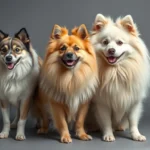
Introduction
Dog breeds play a significant role in our lives, offering companionship, protection, and various working capabilities. Among the numerous breeds, the Rottweiler stands out for its strength, loyalty, and intelligence. While the standard Rottweiler has a well-defined appearance characterized by its black and tan coloration, the emergence of the red Rottweiler adds an intriguing variation to the breed. Understanding this unique color variation is essential for potential owners and enthusiasts alike. This article delves into the characteristics, care, and training of the red Rottweiler, providing a comprehensive guide for anyone interested in this remarkable breed.
Overview of Dog Breeds
What is a Dog Breed?
A dog breed is a specific group of domestic dogs with particular physical and behavioral traits that distinguish them from other dogs. The significance of dog breeds lies in their adaptation to various tasks, environments, and human companionship. Historically, breeding was primarily influenced by the need for specific skills or purposes, such as herding, guarding, or companionship.
Categories of Dog Breeds
Dog breeds can be classified into several groups based on their functions:
- Working Group: Breeds that perform tasks such as guarding and pulling sleds. Example: Rottweiler, Siberian Husky.
- Herding Group: Breeds that assist in managing livestock. Example: Border Collie, Australian Shepherd.
- Sporting Group: Breeds developed for hunting and retrieving. Example: Labrador Retriever, Cocker Spaniel.
- Toy Group: Small companion dogs bred for companionship. Example: Chihuahua, Pomeranian.
- Non-Sporting Group: A diverse group that doesn’t fit into the other categories. Example: Bulldog, Dalmatian.
Understanding these categories helps prospective dog owners choose a breed that fits their lifestyle and needs.
The Rottweiler Breed
History of the Rottweiler
The Rottweiler has a rich history that dates back to the Roman Empire, where they were used as herding and guard dogs. Originating in the town of Rottweil, Germany, these dogs were essential for driving cattle and protecting their owners’ properties. Over time, the breed evolved, gaining recognition for its strength and protective instincts. Today, Rottweilers are beloved family pets and service dogs, showcasing their versatility and adaptability.
General Characteristics of Rottweilers
Rottweilers are known for their robust build and confident demeanor. Here are some key characteristics:
- Physical Traits: Typically, Rottweilers are large dogs, weighing between 80 to 135 pounds. They have a short, dense coat that is primarily black with tan markings. The standard coloration of a Rottweiler is well-defined, but the red Rottweiler presents a fascinating variation.
- Temperament: Rottweilers are often described as loyal, confident, and protective. They are known for their intelligence and adaptability, making them excellent family pets and working dogs.
- Lifespan and Health Considerations: Rottweilers generally live between 8 to 10 years. Like many breeds, they are prone to certain health issues, including hip and elbow dysplasia, heart problems, and certain cancers.
The Red Rottweiler
What is a Red Rottweiler?
A red Rottweiler is a variation of the standard Rottweiler, distinguished by its unique coloration. While traditional Rottweilers have a black and tan coat, the red variation presents a more reddish hue in its markings. This distinct coloration occurs due to specific genetic factors, which can lead to variations in the expected coat colors of Rottweilers.
Appearance of the Red Rottweiler
The red Rottweiler maintains the same robust body structure and overall appearance as its standard counterpart. However, the physical attributes include:
- Coloration: The red markings can range from a lighter tan to a deeper reddish-brown, contrasting sharply with the black coat. This coloration can significantly affect the dog’s overall look, making it stand out among other Rottweilers.
- Size: Like standard Rottweilers, red Rottweilers are large, muscular dogs, typically weighing between 80 to 135 pounds.
Temperament of the Red Rottweiler
The red Rottweiler shares the temperament traits of the standard breed, which includes loyalty, intelligence, and protectiveness. While individual dogs may exhibit slight variations in behavior, the core temperament remains consistent. Owners can expect:
- Loyal and Protective Nature: Red Rottweilers, like their black and tan counterparts, often form strong bonds with their families and can be protective of their loved ones.
- Intelligence and Trainability: These dogs are intelligent and respond well to training, making them suitable for various roles, from family pets to working dogs.
Care for a Red Rottweiler
Diet and Nutrition
Feeding a red Rottweiler requires careful consideration of its nutritional needs:
- Recommended Diet Types: A high-quality, balanced diet that includes protein, carbohydrates, and healthy fats is essential. Look for dog food rich in meat sources, as Rottweilers thrive on protein.
- Common Dietary Restrictions: Be cautious of food allergies and sensitivities, as some Rottweilers may be prone to gastrointestinal issues. Regularly consult with a veterinarian to ensure dietary needs are met.
Exercise Requirements
Rottweilers, including red Rottweilers, are active dogs that require regular exercise:
- Daily Exercise Needs: Aim for at least 60 to 90 minutes of exercise daily. This can include walks, playtime, and interactive games to keep them physically and mentally stimulated.
- Activities Suited for Red Rottweilers: Engage them in activities such as obedience training, agility courses, and fetch games that challenge their intelligence and energy levels.
Grooming and Maintenance
Grooming is crucial for keeping your red Rottweiler healthy and looking their best:
- Grooming Frequency and Methods: Rottweilers have short coats that require minimal grooming. Regular brushing, at least once a week, helps remove loose hair and reduces shedding.
- Coat Care Specific to the Red Coloration: Pay attention to skin health, as some Rottweilers, especially those with unique coloration, may be prone to skin conditions. Regular baths with appropriate dog shampoo can help maintain coat health.
Health Considerations
Regular veterinary check-ups and awareness of common health issues are essential for Rottweilers:
- Common Health Issues: Rottweilers are susceptible to conditions like hip and elbow dysplasia, heart diseases, and certain cancers. Early detection through regular vet visits can improve outcomes.
- Importance of Regular Veterinary Check-Ups: Schedule annual check-ups to monitor your dog’s health, vaccinations, and any emerging issues.
Training a Red Rottweiler
Basics of Training
Early training and socialization are critical for a well-adjusted red Rottweiler:
- Importance of Early Socialization: Exposure to various environments, people, and other animals during puppyhood helps develop a well-rounded temperament.
- Recommended Training Methods: Use positive reinforcement techniques, including treats, praise, and play, to encourage desired behaviors.
Behavioral Training
Addressing behavioral issues effectively is vital for a harmonious relationship:
- Techniques for Addressing Common Behavioral Issues: Consistency is key. For problems like barking or aggression, redirect the dog’s focus and reinforce positive behaviors.
- Positive Reinforcement Strategies: Rewarding good behavior strengthens the bond between you and your red Rottweiler and encourages them to repeat such behaviors.
Advanced Training and Activities
For those interested in further engaging their red Rottweiler, consider advanced training:
- Suggestions for Advanced Obedience Training: Classes may include advanced commands or agility training to enhance obedience and mental stimulation.
- Fun Activities to Engage a Red Rottweiler’s Intelligence: Puzzle toys, scent work, and interactive games can keep their minds sharp and prevent boredom.
Living with a Red Rottweiler
Family Integration
Integrating a red Rottweiler into a family setting requires thoughtful consideration:
- Interaction with Children and Other Pets: Rottweilers are generally good with children and can be protective. However, supervision is essential, especially with younger children.
- Tips for Ensuring a Harmonious Household: Encourage gentle interactions and establish boundaries. Early socialization helps them coexist peacefully with other pets.
Safety and Security
Rottweilers possess strong protective instincts, making them excellent guardians:
- Protective Instincts of the Breed: Rottweilers are naturally protective of their families. Training should focus on appropriate behaviors in protecting without aggression.
- Best Practices for Ensuring Safety: Secure your home with proper fencing and gates, and always supervise interactions with strangers to maintain safety.
Conclusion
The red Rottweiler is a captivating variation of a breed known for its loyalty, intelligence, and protective nature. Understanding the unique characteristics, care requirements, and training needs of this breed is crucial for potential owners. With proper care and training, a red Rottweiler can thrive as a loving family member and a devoted companion. Responsible ownership and advocacy for the breed can ensure that these remarkable dogs continue to enrich our lives for generations to come.









